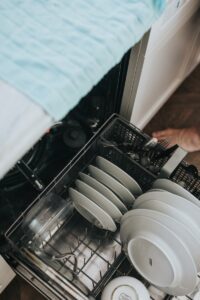Washing the dishes is a task that most people encounter on a daily basis. The average person in America spends approximately 5,000 hours per year washing dishes, which is a considerable amount of time. However, if you’re like many individuals, those dirty plates and utensils tend to accumulate and linger, becoming an eyesore in your kitchen. The good news is that with the right tools and techniques, you can streamline the dishwashing process and reduce the time and effort required. In this article, we will explore effective strategies on how to wash the dishes, ensuring cleanliness and efficiency in your kitchen.
-
 Prepare Your Dishwashing Solution
Prepare Your Dishwashing Solution
To begin the dishwashing process, it is essential to have a well-prepared dishwashing solution. Start by pouring 1 cup of white glue into a mixing bowl, then add 1 tablespoon of baking soda. Thoroughly mix the contents of the bowl to create a suitable cleaning mixture. Depending on your desired consistency, you may need to adjust the amount of glue used. This step ensures that you have an effective and reliable dishwashing solution ready to begin learning how to wash the dishes properly.
-
The Step-by-Step Dishwashing Process – How to Wash the Dishes
The dishwashing process can be broken down into five simple steps: Prep, Fill, Wash, Rinse, and Dry. By following these steps, you can ensure that your dishes are thoroughly cleaned and ready for future use.
2.1 Prep: Scrape off Excess Food
Before placing the dishes in the sink, it is crucial to remove any leftover food particles. Use a utensil or scraper to gently scrape off excess food from the dishes. This step helps prevent clogging your drain and ensures a cleaner washing process.
2.2 Fill: Get Clean, Hot, Soapy Water
Once you have prepared your dishes for washing, fill the sink with clean, hot, soapy water. The temperature of the water should be hot enough to effectively remove grease and grime from your dishes. The soapy water serves as a powerful cleaning agent that will help remove any remaining food residue and stains.
2.3 Wash: Scrub Thoroughly Under the Water
Now that your sink is filled with hot, soapy water, it’s time to start washing the dishes. Pick up each item and scrub it thoroughly using a sponge or dishcloth. Make sure to scrub under the water to ensure optimal cleaning. Pay close attention to areas with stubborn stains or dried-on food particles. By scrubbing the dishes diligently, you can effectively remove dirt and grime, leaving them sparkling clean.
2.4 Rinse: Wash Off all Suds and Residue
After scrubbing each dish, it is essential to rinse off all the soap suds and residue. Rinse the dishes under running water, ensuring that no soap is left behind. This step helps prevent any soapy taste on your dishes and ensures that they are completely clean.
2.5 Dry: Air Dry or Towel Dry
Once the dishes have been rinsed, you have the option to either air dry them or towel dry them. If you choose to air dry, place the dishes in a designated area where they can dry naturally. Alternatively, you can use a clean, dry towel to wipe away any excess moisture. Ensure that all the dishes are completely dry before storing them to prevent any lingering moisture that could lead to bacterial growth.
-
 Enhance Your Dishwashing Experience
Enhance Your Dishwashing Experience
To take your dishwashing routine to the next level, consider incorporating essential oils into your cleaning process. Essential oils such as lavender, lemon, peppermint, and tea tree offer additional benefits beyond cleaning. They help deter odors, prevent bacteria growth, and possess natural antibacterial properties. For instance, lavender oil can reduce stress levels, fight depression, and improve sleep quality. Lemon oil is excellent for improving skin health and digestion, among other benefits. Peppermint oil can clear sinuses and stimulate the appetite, while tea tree oil is effective against various infections. Add a drop or two of pure essential oil to your dishwashing solution to impart a pleasant fragrance while reaping the additional benefits provided by these oils.
-
Applying the Principles to Other Household Chores – How to Wash the Dishes
The principles and techniques discussed in this article can be applied to other household chores as well. Whether it’s laundry, vacuuming, mopping, gardening, yard care, car maintenance, or cooking, understanding the basic principles of efficiency and organization can make a significant difference. Take inventory of the tasks in your home, identify areas that need improvement, and prioritize them based on importance. By systematically tackling each task and ensuring completion, you can maintain a clean and organized living space.
Mastering the art of how to wash the dishes involves following a systematic approach that combines effective cleaning solutions, proper techniques, and optional enhancements such as essential oils. By adhering to the step-by-step process of Prep, Fill, Wash, Rinse, and Dry, you can ensure that your dishes are impeccably clean and ready for use. Moreover, applying the principles discussed in this article to other household chores will enable you to maintain an organized and efficient living space. Embrace these techniques, and transform your dishwashing experience from a mundane task into an opportunity for cleanliness, order, and satisfaction.
Leave a Reply